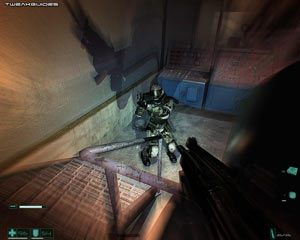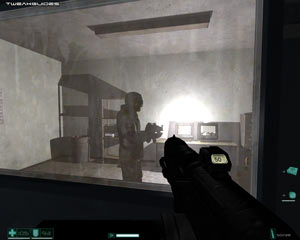FEAR Tweak Guide
[Page 7] Advanced Tweaking
Config Files
FEAR has three major .cfg (config) files. These are the Default.archcfg and autoexec.cfg files under the \Program Files\Sierra\FEAR directory, and the most important one of all for our purposes: the Settings.cfg file under the \Documents and Settings\All Users\[Shared] Documents\Monolith Productions\FEAR directory. You can edit these files using a text editor like Windows Notepad, however back them up before making any changes just to be safe. The major settings under each file are described below:
Update: The FEAR Extraction Point demo uses the same settings.cfg file structure, however it stores this file under the \Documents and Settings\All Users\[Shared] Documents\TimeGate Studios\FEARXP-SPDemo\ directory instead.
Settings.cfg
"ScreenWidth" "1280"
"ScreenHeight" "1024"
FEAR does not support certain resolutions from within the game. Fortunately you can assign a custom resolution by editing these lines in the Settings.cfg file. However before setting a custom resolution, first go into the Options menu in FEAR and set the Display options you want (aside from resolution). Next, close the game and Edit the lines above - change the ScreenWidth to the pixel width of the custom resolution you desire, and the same for ScreenHeight. Upon restarting the game your custom resolution will be applied. However don't go back into the Display settings screen in the in-game options as this will reset your resolution to one of the default resolutions. To check your new resolution go to Performance>Advanced Video Options and check the 'Screen Resolution' setting which should display the new resolution. You can now adjust and test the remainder of your settings.
If your resolution is accidentally reset, re-edit this file, or make it Read Only once you applied all the tweaks you want. Also, if you find this method doesn't work for you, you may have to create a new Profile and/or delete your other profiles for it to work.
"BitDepth" "32"
By changing the BitDepth to 24 or even 16, you may be able to improve the graphical performance. Lower bit depths can result in more color banding (noticeable gradations). Note you will have to make the Settings.cfg file Read Only for this setting to stick, and it may have no impact on your system.
"HardwareCursor" "1.000000"
If you're having problems using your mouse in the in-game menus or in the game, set this to 0.
"VSyncOnFlip" "0.000000"
This option simply controls whether VSync is On or Off. Recommended is Off (0.000000), however ideally you should set this using the in-game option.
"DisableMovies" "1"
You can add this line either manually or by using the FEAR Config Tool (see below) - the preferred method is to use the tool. Setting this option to 1 skips all the introductory movies in the game allowing for a quicker startup.
"RestartRenderBetweenMaps" "1.000000"
This option controls whether the Force Restart option (covered on page 5 of this guide) is enabled or not. This setting was added recently to FEAR, as well as being standard in FEAR Combat and FEAR Extraction Point. You should alter this setting using the in-game settings as normal.
These are all the known working .cfg file commands at the moment. I will add more as they are discovered.
Default.archcfg
This file simply seems to contain the archive names which the game needs to open upon loading up. While commands may be able to be inserted here just like Settings.cfg, I haven't been able to make any useful commands work from here. Note again that this file is write protected by default and may need to be re-protected for any inserted commands to work.
Autoexec.cfg
This file would be ideal for inserting additional commands rather than placing them in the files above. However I have not found any useful ways of making commands work when placed here.
FEAR Advanced Config Application
To run the FEAR Advanced Config Application, go to your \Program Files\Sierra\FEAR directory and run the Config.exe file. Upon starting this tool up, on the main page you can see it simply allows a choice of resolution, renderer and display adapter. The Resolution setting is useful if you are having problems getting into the game from using a non-standard resolution - reset it here to a standard one by highlighting it and clicking the Save button. The Renderer and Display options have only one choice by default.
Under the Options tab of the tool, you'll find additional options which are explained in more detail in your FEAR Readme.txt file. For the most part these options are for troubleshooting purposes:
Disable Sound: Removes all sound from the game. This improves performance however obviously is not recommended. Use this setting to isolate whether your sound card is the source of a problem. If you tick this option and can run FEAR with reduced problems, your sound settings, sound drivers or sound hardware are one source of the problem.
Disable Music: For a slight boost in available memory and performance, click this option to remove all FEAR music.
Disable Joysticks: Tick this option to disable all joysticks and gamepads. This may resolve any problems you are having with keyboard and mouse controls in the game.
Disable Movies: Disables the startup movies. It is recommended you tick this option to skip the startup movies. Note this option doesn't affect the in-game movies, only the introductory company movies which play before the game menu loads up.
Disable Sound Filters: Sound Filtering effects will be disabled if ticked, meaning EAX reverberation effects. This can help reduce audio glitches such as crackling on cards with EAX 2.0 support, but will reduce audio special effects.
Disable Hardware Sound: Once again used to isolate whether your sound card is a problem by forcing Software Sound support only in FEAR. This can improve performance as well but reduces audio quality noticeably.
Console Commands
Unfortunately since writing my FEAR Demo Tweak Guide, I still haven't found any way of enabling the full in-game console. The best that's been discovered so far is how to enable a range of cheats. To do this, press your Talk key (default is T) while in-game. At the talk prompt, type one of the following commands to enable the relevant cheat.
ammo - Full ammo
armor - Full armor
health - Full health
god - God mode
guns - All weapons
maphole - Next level
kfa - All weapons + full ammo, armor & health
tears - All weapons + infinite ammo
gear - Increased health and boosted reflexes
gimmegun Pistol - Pistol
gimmegun Dual Pistols - Dual pistols
gimmegun Submachinegun - SMG
gimmegun Shotgun - Shotgun
gimmegun Assault Rifle - Assault rifle
gimmegun Semi-auto Rifle - semi-auto rifle
gimmegun Nail Gun - Nailgun
gimmegun Cannon - Cannon
gimmegun Plasma Weapon - Plasma railgun
gimmegun Missile Launcher - Missile launcher
gimmegun Turret -
gimmegun Frag Grenade - Frag grenade
gimmegun Proximity - Trip bomb
gimmegun Remote Charge - Pipe bomb
mods -
baddaboom -
poltergeist - Ghost mode
build - Build version
pos - Player position
I have the strong feeling that the console has purposely been disabled in FEAR, and hence although I have a long list of console commands which might be of use (and which I originally included in my FEAR Demo Tweak Guide), none seem to work regardless of where I used them - whether in the Talk console mode, in one of the config files, or in the Target box of the FEAR icon. If you somehow discover how to access the full in-game console, please Email Me so I can share it with everyone here (and give you full credit for it).
The next section brings this guide to a conclusion, providing some useful information.


